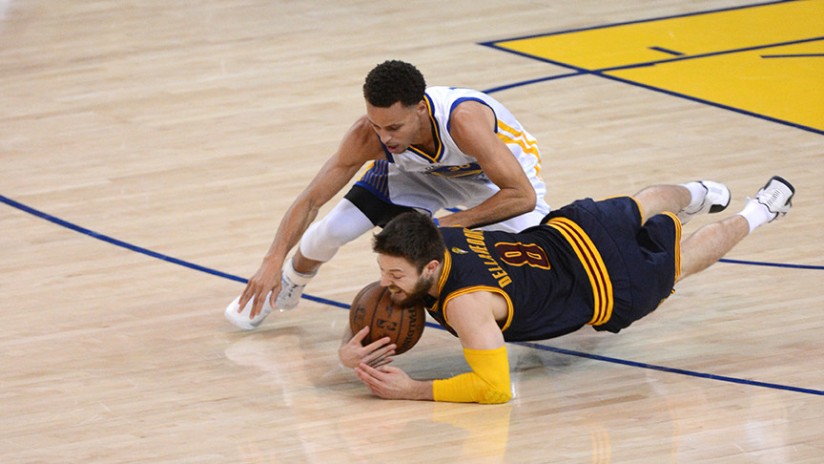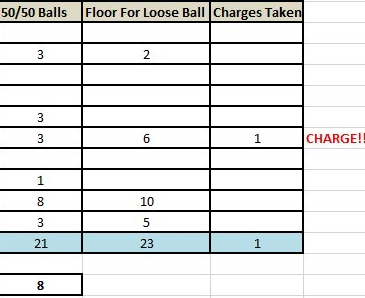Hustle Plays: The most important stat that often gets overlooked
Boston Celtics coach Brad Stevens once said, “Be great at things that take no talent.” This is something I always believed in as a coach, but highlighting this for the entire team was a challenge. Hitting the the floor for a loose ball, taking a charge, sprinting back on defense, and boxing out are all examples of “things that take no talent”. I decided to track stats that might not take talent, but required a lot of heart and determination. To me, these stats are the difference in a close game and are especially important when you make it to the state tournament.

Before my 1st year as head coach, in 2012-2013, I was watching an ESPN All-Access on Coach Calipari and Kentucky. In the documentary Coach Calipari talks about effort in practice and games and reveals that he keeps track of “hustle” plays. This helped me to further develop my ideas on tracking “hustle” plays.
Hustle Points
There are many opportunities to highlight hustle and effort during a basketball game or practice. I think all coaches try to do this in one way or another, but tracking hustle points further emphasizes the importance of taking charges or hitting the floor for a loose ball. That said, I’m sure some coaches might think hitting the floor for a loose ball is an expectation and they’re right. However, scoring and rebounding are also expectations and it is pretty safe to say that all coaches keep track of them. Hustle plays shouldn’t be any different than tracking other stats. There is an opportunity for a hustle play every time down the floor, but in the flow of the game these plays can often get overlooked.
Earning Hustle Points
Players can earn hustle points in a variety of ways and I think it really depends on what a specific coach wants. In my opinion, there are a few areas that must be included and then coaches should decide if they want to add in other areas. Most importantly, the players have to be aware that these stats are important beyond a coach yelling “take a charge”. Players have to understand the impact this play or other hustle plays can have on a game. Hitting the floor for loose balls, taking charges, and winning 50/50 balls are non-negotiable hustle plays for any team I coach, but we also have highlighted other areas as well. For example, sprinting back to chase a player down in transition, back tapping a ball, or even keeping a ball alive in a variety of ways. Here are some ideas for areas you can track in addition to the “big three” I mentioned:
- charges attempted/taken
- hitting the floor for loose balls
- 50/50 balls
- back tapping
- traps in the press
- keeping plays alive on offense and defense
- saving a ball out of bounds
- tapping a rebound to a teammate
- deflections
- sprinting in the press or in transition to make a play
- help defense (many options here)
- multiple rebounds in a possession
- plays in transition offense (ie. rim runner out sprinting defender for easy layup)
Coaches may also want to take points away from players for things like turnovers, getting beat 1 on 1 in defense, not closing out, missed box outs, or not getting into help defense. My coaches and I had some argument as to whether a turnover is an anti-hustle play, but we also didn’t want players who were flying around on the court and then being careless on offense. On the flip side, if a player had a turnover and then hustled back to make a play they could earn points.
We weighted points for different hustle plays to reflect the importance and difficulty. For example, a charge was worth multiple points or saving a ball out of bounds on defense and then sprinting by the defense to get a transition layup. Naturally plays are happening fast in a game, but we also used film to share hustle plays with our team and also review our charts.
Tracking Hustle Points
Former management consultant, businessman, and author Peter Drucker said, “If you can’t measure it, you can’t improve it” which is true for just about everything in life. In basketball, however, I like to say “that which gets measured, gets improved,” including hustle plays. Every coach has yelled at a player to “take a charge” or “hit the floor for a loose ball” at some point in their career, but at the same time, many coaches do not track these stats and other important hustle plays. If there is an expectation that players are going to improve in these areas, then hustle plays should be tracked the same as deflections or steals.
As half time was approaching in each of our games, my assistant coaches would start to tally stats, including hustle points. When the buzzer went off for halftime we would confirm fouls/score with the scorer’s table and then I’d looked at my coaches and say “How many hustle points do we have?” and wait for their reply. My coaches would share the number and then say something to the effect of “we are killing them in 50/50 balls and hitting the floor for every loose ball” or they could say “we have less than 50 points and are losing 50/50 balls with no charges taken”. When I heard something similar to the first statement we’d be up (yes we tracked this as well) and when I heard the second comment it probably wasn’t our best half to put it nicely. We had 10 minutes for half time so we would the first 2 minutes to review hustle points and other stats, discuss adjustments, and each assistant coach would have a brief talking point (typically 30 seconds or less). I used the majority of half time to review our adjustments and would always highlight hustle points. Our goal was 50 hustle points in a half and 100 for the game.
We kept overall hustle points as part of our stats with different categories and shared that number with the team. 50/50 balls, hitting the floor for loose balls, and charges taken/attempted were part of the hustle points, but also highlighted separately because these were focus areas for our team.

The above chart happened to be recorded during a game we were down a few players and had to play six or seven as a result. We ended up beating a high quality team and you can see the effort these players gave in the game by viewing the chart. Two of the players didn’t hit the floor for a loose ball, but there may not have been opportunities, which was the case in this game. In our press certain players were usually in position to hit the floor depending on the game. The important thing was that players did not pass up an opportunity to fight for a loose ball. Tracking hustle points allows coaches to highlight these plays at half time and after the game, while also ensuring these valuable plays don’t “slip through the cracks” and get overlooked.
We also had a chart with other hustle plays that we kept throughout the game. It had everything from deflections and keeping a ball alive to missing a box out (minus points). We kept (below) an overall chart that we added to throughout the season. We revised this a bit over the years, but you’ll get the basic concept when you look at our one from the first year.

At this point, we were limited in what we gave out for hustle points and really focused on the basics. Each year we added new categories and revised our hustle points to reflect what we valued as a team. That said, we had higher hustle point totals in later years (100 per game) as a result of what we tracked. I believe our original goal was 30 points just based on taking charges, hitting the floor for loose balls, and 50/50 balls. Over they years, the Hustle Ball became a symbol of pride for our program long before the Miami Hurricanes football team incorporated their “Turnover Chain”.
The Hustle Ball
Each week during the season you can open the local newspaper in your area and find the top scorers and even some other stats like assists, steals, and rebounds. However, it is very rare, if at all, that you see the top hustle player. If a player takes a key charge to win a game you will read about it, but very rare to read an article that focuses on how many times a team dives on the floor, keeps a play alive, or sprints back to stop a transition layup. My point is that these areas have to be emphasized within your program because it is easy for kids to read the newspaper and question why they are getting floor burns each night. Of course, my advice is to not read the papers during the season because you are never as good as they say you are and never as bad either.
The hustle ball was symbolic of our style of play. We highlighted hustle points after wins and losses, but decided as team to only give it out after a win. Originally, we gave our “hustle ball” to a player at the end of the week (below), but we decided to do it after each win in later years.

The player who was awarded the hustle ball got to keep it with them until the next game Player signed it the first time they earned it and then put a mark next to their name if they received it more than once. It became very difficult for players to separate from the Hustle Ball when it was time to give it up before our next game. Players often brought it to school and other places with them and it even showed up in some pictures along the way. The Hustle Ball led to our end of the season “Hustle Award” (above) and put further emphasis on what we believed was a difference maker for our team.
Conclusion
Regardless of the age group you coach or style of play you use, the Hustle Ball and tracking hustle points is a must. Hustle plays are the difference between winning and losing in close game. Every coach has a story of a kid saving a ball, hitting the floor for a loose ball, or taking a charge in critical moment to propel their team to victory. At the same time, coaches have to go one step further with hustle/effort plays. Coaches should practice taking charges (See link, The Great Difference Maker) in addition to other hustle plays.
In this post I have shared some basic ideas on the premise of tracking hustle points and emphasizing effort by incorporating a Hustle Ball or other hustle based reward system with your team. I can’t emphasize enough that hustle plays were a difference maker for our team. We tracked our points in wins and losses and saw a direct correlation between our effort and on court success. There are many ways to track hustle plays and reward them, but the important thing is making sure players fully understand that hitting the floor for a loose ball or taking a charge are expectations. Not only are they expectations, but they are important enough that they will be tracked and measured for growth and improvement each practice or game!
If you have any questions or would like any additional ideas regarding hustle points please feel free to reach out!
#GetBetterEveryDay
-Coach DeMarco

